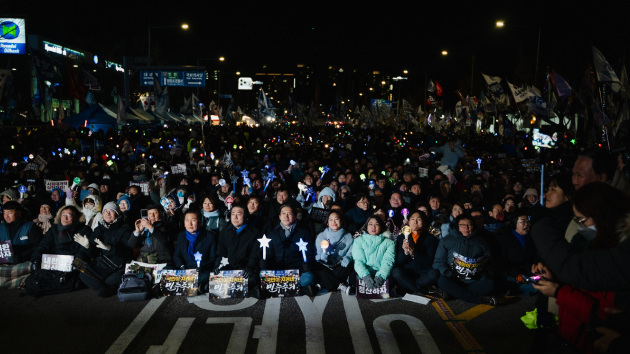Israel continues strikes on humanitarian area in Gaza despite official designation
Written by ABC Audio ALL RIGHTS RESERVED on August 1, 2024
(LONDON) — Israel’s military has conducted at least eight airstrikes in recent months in an area it designated as an expanded humanitarian zone, an ABC News investigation has found using verified videos, photos and personal testimonies.
Israeli officials confirmed the strikes to ABC News, but maintained they were efforts to destroy Hamas militants, commanders and infrastructure hidden within Palestinian neighborhoods. The strikes examined by ABC News all together killed at least 110 people, according to the Hamas-run Gaza Health Ministry, and hit hospitals in the safe zone that treated victims.
International observers said the strikes, which occurred over a period of weeks, raised questions about whether Israel had intentionally targeted areas where they directed civilians to take refuge. Doing so could be a war crime, according to international law experts.
Muntaha Zaqzouq, 20, moved to this expanded humanitarian area from the southern Gaza city of Rafah after the Israel Defense Forces warned civilians to go there.
At least 800,000 people fled Rafah in May, the majority of whom found shelter in the expanded humanitarian area, according to the U.N. Relief and Works Agency, or UNRWA, which works with Palestinian refugees.
Zaqzouq and her two siblings were in their tent in the courtyard of a school when a bomb fell nearby, on July 3, she told ABC News in an interview. The siblings rushed to each other’s side, huddling together inside the tent, before a second bomb ripped apart their tent, she said.
“When the dust started to clear, I looked and found my brother full of blood. I looked at myself and found that I was full of blood, my T-shirt, and my legs had blood on them,” she said.
Zaqzouq’s brother needed 35 stitches to his head, and she herself needed stitches to her leg, she said.
Satellite images and ABC News video corroborate Zaqzouq’s story, showing two strikes north of the school where she was living with her siblings, and her tent shredded.
She and her family had moved six times before settling in the safe zone in Khan Younis, near Nasser hospital, she told ABC News. She said the IDF did not warn them before the bombings.
“No one warned us, no one said that there would be a strike, and they did not call anyone. The strike happened suddenly and the square was full of people sitting outside,” she said.
The IDF told ABC News it “struck a terrorist infrastructure at the provided coordinates.”
As the IDF launched its ground operation in Rafah in May, the Israeli military announced the expansion of an official humanitarian area where the city’s residents could go to be safe.
In a May 6 post on social platform X, the IDF spokesperson for Arabic Media released a map of the designated humanitarian area, which had been expanded to include not just Al-Mawasi, a small area in the southwest of Gaza, but also the western parts of the nearby city of Khan Younis and the entire city of Deir al-Balah to the north.
“For your safety, the IDF calls on you to evacuate immediately to the expanded humanitarian zone,” the post said.
Confirming the borders of the humanitarian area, the IDF in June referred ABC News to their website which has an interactive map of Gaza with the humanitarian zone outlined. Text on the page, referring to following IDF instructions related to the map, reads, “Residents of Gaza! It is a safe way to preserve your safety, your lives, and the lives of your families.”
The IDF amended the boundaries of the humanitarian area on July 22 and again on July 27, removing portions to the east of the “safe zone,” because of what it said was “significant terrorist activity and rocket fire toward the State of Israel from the eastern part of the Humanitarian Area in the Gaza Strip.” None of the IDF airstrikes examined by ABC News occurred in these areas.
ABC News asked the IDF about eight specific airstrikes in the humanitarian area.
“The IDF does not aim to strike humanitarian areas as such,” the IDF told ABC News in June, saying that Palestinian militants use civilian infrastructure for military purposes, but that, “Nevertheless, and on account of the concentrated presence of civilians in these areas, the approval process for these strikes is more stringent.”
In another statement to ABC News in July, the IDF accused Hamas of increasing “its military presence and operations from humanitarian zones,” including firing rockets toward Israel.
The rules around strikes on safe zones are clear, according to David Crane, an American international law expert who has prosecuted war crimes for the United Nations.
“There’s no gray area, it’s black and white,” he told ABC News. “If you intentionally target a safe zone where there are civilians, that’s a war crime.”
Janina Dill, co-director of the Oxford Institute for Ethics, Law, and Armed Conflict, said that there are strict legal rules under international humanitarian law, which is based on rules laid out in the Geneva Conventions, for what is considered a safe zone. She said she believes “Israel’s so-called safe zones do not easily meet the criteria of any of these legally recognized areas.” Thus, strikes in this area would not alone be enough to designate a war crime, she said.
She said that when Israel creates “safe zones” it can be seen as the military attempting to fulfill its legal obligations to warn civilians before attacks in combat areas.
Dill said that attacks in areas designated by Israel as safe “that kill a lot of civilians weaken the legal framing of the evacuation orders as improving the safety of the civilian population.”
Dill also said that when “reasonably foreseeable” civilian casualties are greater than the military advantage of an attack, the attack is prohibited under international law. This is called the “principle of proportionality,” and Dill said when civilians are displaced to an area Israel designated as safe, civilian casualties from attacks in that area are necessarily “reasonably foreseeable.”
She said that “it is very possible that some of these attacks in safe zones are war crimes because they are clearly disproportionate, or they could also be indiscriminate. However, generally, criminality can definitively only be established in and by a court of law.”
Palestinian journalists and Gaza residents who were near three of the strike sites in the humanitarian zone told ABC News they had received messages from the IDF warning them to evacuate the building before an imminent strike. Within a few hours, videos verified by ABC News show the buildings were destroyed by IDF airstrikes.
The IDF told ABC News they were targeting military infrastructure belonging to Hamas and the Palestinian Islamic Jihad at each of the three sites where prior warning was given.
An IDF airstrike in northwest Rafah killed at least 45 people on May 26, according to the Hamas-run Gaza Health Ministry. The IDF said it had not conducted that strike within the borders of the humanitarian area.
“Contrary to circulating reports, we carried out the aforementioned strike outside the area considered a humanitarian zone to which we invited residents to move,” an IDF spokesperson wrote in Arabic on X on May 26.
But two days before, on May 24, the IDF dropped a bomb on a tent camp in Al Mawasi, in the center of the humanitarian area.
A journalist within a few hundred yards at the time of the strike told ABC News people received warning to evacuate before the strike and that no one was killed as a result.
Verified video filmed in the aftermath of the strike shows the massive crater left behind, and people attempting to dig up destroyed tents and belongings.
A woman who witnessed a strike in Khan Younis on June 20, who did not want to share her name for fear for her safety, told the ABC News team in Gaza, “People here came to the Khan Younis area and Nasser Hospital on the basis that it is a safe area. Schools for displaced people have been evacuated.”
Two of the strikes where warnings were given were within 100 feet of schools housing displaced people. Videos from Khan Younis show destruction at the nearby school, with parts of the walls missing and debris covering beds.
Other strikes, including five that ABC News has studied, were not preceded by IDF warnings, witnesses and victims said. ABC News provided the IDF with the details of deadly strikes for which there were no public warnings, but the IDF declined to specify whether precautions were taken to minimize civilian harm in those cases.
Several explosions followed by clouds of smoke sent people running in the Al Mawasi area of Gaza on July 13, as seen in social media videos from the scene, that were verified as authentic.
First responders in ambulances and fire trucks rushed toward the scene. As they arrived, another explosion rang out, video shows, this one on the street where medics had stopped, north of the first strike.
ABC News’ cameras captured dozens of people, including women, children and first responders, rushing into the nearby Nasser Hospital. Ninety people were killed and 300 injured in this attack, the Hamas-run Gaza Health Ministry said.
The IDF said the strike was targeting Mohammed Deif, the commander of Hamas’ military wing and a key figure behind the Oct. 7 attack. An Israeli official also told ABC News that they believe “that many of the casualties were also terrorists.”
The strike was one of the deadliest single events of the war.
“There is no ‘safe’ or ‘humanitarian’ zone in Gaza. These ‘designations’ were misleading and deceiving,” the commissioner general of UNRWA, Philippe Lazzarini, said following the strike.
An earlier IDF airstrike on July 2 hit a home in Deir al-Balah, killing 13 people, including four children and two women, according to the nearby Al Aqsa Martyrs Hospital, where the bodies were taken.
Video from the scene shows rescuers digging through the rubble of the upper floors of the house, where the walls appear to have been blown out.
The IDF told ABC News that it “struck a terrorist operative in a military building” but did not comment on the deaths of the women and children also in the building or whether specific measures to avoid harming civilians were taken in this strike.
Another strike on June 14 hit another home in Deir al-Balah not far from the Al Aqsa hospital, videos show. Two people were killed, according to the Hamas-run Gaza Health Ministry.
Verified videos filmed by local journalists show at least four children being rescued from the building. People are seen digging through rubble to free two of them. Once one girl is freed, the footage shows her taken to an ambulance, where a young boy, blood covering his face, is already on a stretcher.
One video also shows an unconscious woman being rushed to a waiting ambulance, and medical responders attending to an elderly woman emerging from the building.
Asked about this strike, the IDF told ABC News that it “struck a military infrastructure at the coordinate provided.”
The IDF told ABC News that Palestinian militant groups “embed their military objects strategically in, near, and under civilian infrastructure including humanitarian zones.” The IDF also claims Hamas members routinely use Palestinian civilians as human shields.
Dill, the Oxford international law expert, said that civilian casualties must still be taken into account in these situations.
“If an attack against this Hamas member would be disproportionate – due to the use of civilians as human shields in a safe zone – this attack would still be prohibited,” Dill said. “The violation of international law by one party to a conflict does not release the other party from its own obligations neither does it – generally – weaken these obligations.”
Crane, the former UN prosecutor, said safe zones should always be protected.
“If you have safe zones and you have civilians moving into the safe zones, with the understanding that they will not be targeted, that’s important,” he said. “If Israel or Hamas or any, any party to the conflict, if they violate that, then they are in fact committing war crimes.”
Copyright © 2024, ABC Audio. All rights reserved.







